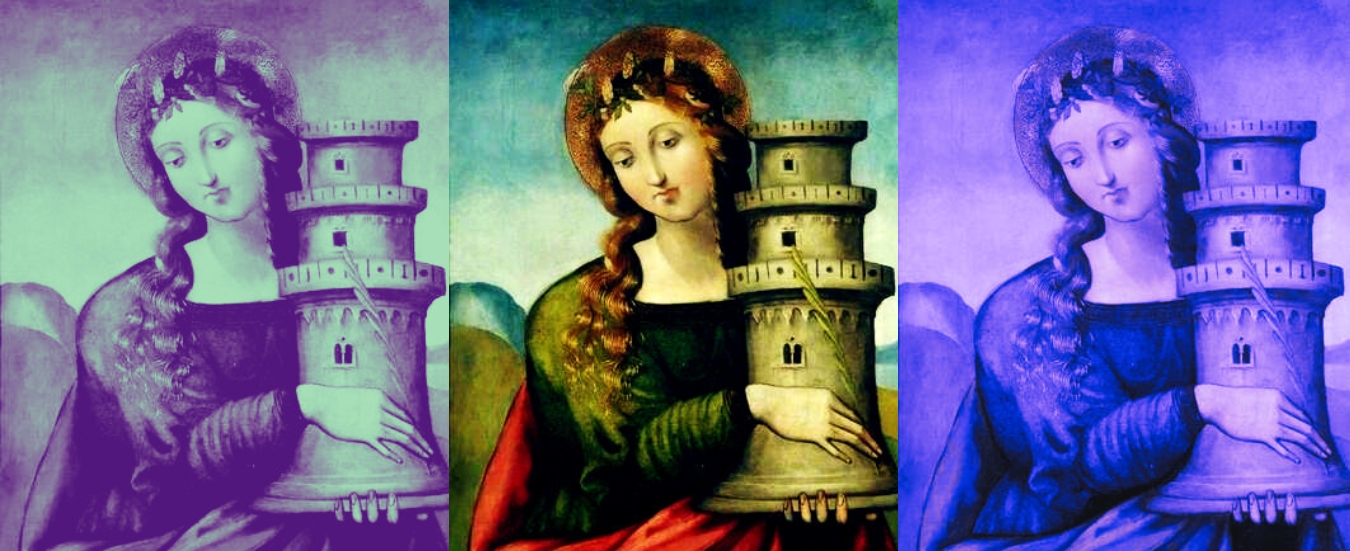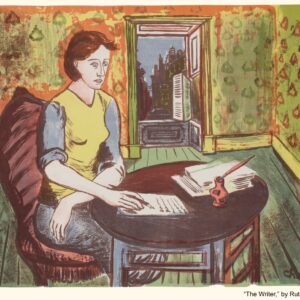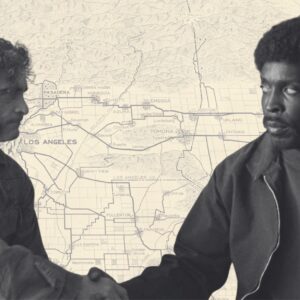
Locked in Rapunzel’s Tower: Reflections on the Art Monster and Women’s Loneliness
Amie Souza Reilly Reimagines the Fairytale’s Sorceress, Surrealism, and Motherhood
I’m in Vermont, in a small bedroom, lying on a twin bed. I am in this room to write, but instead I’ve been staring at the ceiling, long enough for my hair to dry.
The room I’m in is one of four small bedrooms in a suite, and as I’ve been staring, I’ve been thinking that if I were to take off the roof of this building and look down, these rooms would resemble a body—the living room at the head juts out over the long galley kitchen torso, which sprouts four bedroom limbs at its edges. I am in the left leg.
But I am not alone up here like some trapped Rapunzel. I am here with three friends, each in her own limb-bedroom, hopefully not staring at their ceilings.
The thing about Rapunzel is the sorceress is depicted as crone-like and cruel, hoarding her vegetables, terrorizing her neighbors, forcing them to surrender their infant daughter to her, a daughter she locks inside a stair-less tower once she reaches puberty. I can’t help but think about how the sorceress was also trapped, not inside a tower, but behind the high wall that surrounded her property. How she first locks Rapunzel inside that phallic tower, but then exiles her again when she discovers she has fallen in love with a prince, snuck him up to her room, and gotten pregnant.
In the forest, Rapunzel gives birth to twins alone in the woods. Before we even get to interpreting that tower as a representation of the ways we live inside misogyny, we might see those walls as proof society has always needed women to be lonely.
Before we even get to interpreting that tower as a representation of the ways we live inside misogyny, we might see those walls as proof society has always needed women to be lonely.
The friends I am here with are also writers, all here for uninterrupted time to write. All of us are also mothers. Beth pokes her head into my room to see if I’d like some tea. In a few hours, the four of us will close our laptops, walk downstairs, and sit around a large table to eat dinner.
We’ll join the chef, who will tell us she used to be a rug designer. At the head of the table, the director, a poet, will tell us about his childhood, then he will clear the dishes. His daughter, a librarian with impeccable taste in sweaters, eats with us, too. When the four of us go back upstairs, we’ll note how productive we feel because we did not have to think about what to make for dinner.
Right now, though, I’m trying to finish an essay about the art monster and mothers, about loneliness and safety nets. An art monster is someone who disregards all obligations, including family, to bring art into the world. An art monster has no worry of laundry or groceries, health insurance or rent, because the art monster (gets to?) rely on others to keep him clean, fed, rested, and functioning.
This art monster is, in many ways, like a baby, which is why the art monster is rarely a mother. A mother cannot be a baby if she already also the mother.
Now that my son is seventeen, he does not need me in the same urgent, dependent way he used to. When he was an infant, I thought this phase would feel like freedom. But up here, three hours away from home, I miss him, I miss my husband. I pick up my phone again and again to check in. They are fine, they say, and they miss me, too.
The art monster is an archetype of the lone artist. The term originates in Jenny Offill’s novel Dept. of Speculation. In it, a woman becomes a wife and then a mother. Before she marries, she claims she wants to be an art monster, but after the marriage and then the baby, she cannot. When her marriage falls apart, she has neither the art nor the family to catch her.
Offill’s story is also about a woman alone. I am not alone, up here in this Vermont house, but I do feel a little lonely.
Clare Dederer says, “For me the particular monstrousness of completing my work has always closely resembled loneliness: Leaving behind the family, posting up in a borrowed cabin or a cheaply bought motel room.” Hers is not the art monsterhood of stoic dedication and voluntary shut in, but a colossal feeling of loneliness. When I am in the common spaces of this suite with my writer friends, we speak more often of our children than our work.
Beth says the tea is ready. I pull myself out of bed to meet her on the couch. Outside, the snow is squalling. We blow on our tea and Beth asks me if my thoughts appear to me in images or narrative.
Beth and I met during our low-residency MFA; we were dorm neighbors. She’d come to the program immediately after she’d dropped her youngest off at college. My son was eleven and it was the December before Covid shut us all inside.
I’m not sure how to answer her question, so I say in associations, because often one thought clicks into another, language and picture concurrently, though writing about visual art helps me to see it better. She nods at me and smiles. We go back to our laptops, and my loneliness from before seems to have, if not disappeared, shifted. I can miss my family, but in this room, I am no longer lonely.
As Beth writes, I look at a photograph I’ve been writing about by Kati Horna. It is a picture of surrealist painter Remedios Varo, her face in profile, wearing a mask that is also a hat. Even though Varo’s actual face is fully visible, the mask-face covers her right ear, its chin resting on her shoulder. Leonora Carrington, also a surrealist painter, made the mask.
Horna, Varo, and Carrington first met in Paris then fled Europe during WWII, eventually settling in Mexico, where they lived a collaborative life—collaborative mothering, collaborative artmaking, collaborative cooking. In their kitchens, they mixed herbs into potions. They are frequently called the Three Witches of Surrealism.
King James required all biblical references of witches to be rewritten as female. Carl Jung wrote that the witch archetype is a common portrayal of women, usually old women who lived alone. Witches are believed to be and are often depicted as evil practitioners of dark magic, casting selfish spells to better themselves or harm those who cross them.
The sorceress in Rapunzel might be seen as an archetypal Jungian witch. In the Disney version, Tangled, she is based on Dame Gothel who cast a spell on herself to remain perpetually young and beautiful. In children’s fairy tale books, she is frequently drawn as old, ugly, more like the witches in Macbeth, who have choppy fingers, skinny lips, and beards.
A chin hair is one of the first signs the protagonist in Rachel Yoder’s Nightbitch notices in her transformation from suburban mother to nighttime dog. Her change is a metaphor, a manifestation, a physical representation of the frustration and tumultuous violence she feels as she loses her artist self to the minutiae of motherhood. Nightbitch starts out as a mother alone, but her dogness serves as a mask, one that allows her to seek her pack.
Nightbitch went back to work after her son was born, but she sacrificed her career to stay home with her son. At work, she missed him. But at home with him, she missed work. This struggle is played out for many mothers—many primary caregiving parents—a game of tug of war that never ends and always hurts.
This emotional turmoil gets further complicated by capitalism and patriarchy. Working mothers are not guaranteed maternal leave, though even if she is employed somewhere where leave is offered, she rarely receives more than eight weeks, and in that time off she must adhere to policies established to allow for changes in pay and healthcare.
Returning to her job post-partum means working while worrying about the baby at home as well as her own body’s fluids and pain while battling through exhaustion. A mother who does not work outside of the home may not leak breastmilk during her workday, but she is without the companionship and adult conversation a job offers. She is also without money. Either way, a newly post-partum body makes one feel isolated and alone.
Additionally, especially during early motherhood, many find it is nearly impossible to leave the house before some bodily need resurfaces, so even if there is a social network for a mother to reach for, it is excruciatingly hard to get to.
Nightbitch portrays this particular loneliness, this isolation that settles in for the work-in-home mothers who are partnered, but due to the pressure of moving from two incomes to one, especially at a time of increasing financial need, cannot find the balance between home and work, the work of the home, and the exhaustion of increased hours means more time apart at precisely the time when more togetherness is needed.
Single mothers not only must sort out all of the above without the support of a partner, but must also grapple with the criticism lobbed at her by an entire society that often assumes her to be a failure at all they had expected of her.
Single mothers not only must sort out all of the above without the support of a partner, but must also grapple with the criticism lobbed at her by an entire society that often assumes her to be a failure at all they had expected of her. And I have not even mentioned the cavernous ache of post-partum depression, of all the hormonal shifts.
Oh! And childcare is unaffordable. Motherhood, in all its varieties, is lonely by design.
In Nightbitch, Yoder writes: “And she loved the thought of having twenty other wives to live with.”
After dinner with the chef, the director, and his daughter, but before we go upstairs, a tiny sadness shivers through my stomach. The chef and the daughter are standing at the door, putting on their boots. Their departure is about to create a small break in the comfortable friendship that had bloomed at the table.
Eugenia must feel it, too, because she gets up quickly and asks them to stay for just a minute more, says she has something she wants to give them. She darts upstairs and we fall briefly quiet.
Eugenia isn’t only a novelist, but a jewelry maker. She comes down carrying pairs of dangling earrings for these women to choose from, for them to wear home. Rachel and I are already wearing ones she made for us, Beth wears a bracelet.
In the book Surreal Friends about Varo, Carrington, and Horna, Joanna Moorhead (who is also Carrington’s cousin) writes, “Domesticity and motherhood, which sometimes prove the shackles to a woman’s creativity, seemed instead to liberate the potential of the Surreal Friends.”
Art-making is solitary, which is different from lonely. Solitary means there is a network somewhere, a team of caregivers. The art monster is celebrated for being a lone creator, a self-sufficient solitary genius. But he is not self-sufficient, he is merely able to ignore the invisible safety net that keeps him aloft, alive. He is alone, but not lonely.
Here, in this big house full of small suites, the loneliness of motherhood dissipates, mostly, and the safety net needed to create art becomes visible, connective. Tomorrow morning we will leave this place. We will go back to our homes, our partners, our aging and ailing parents, our children. We will return to our homes and jobs, to vacuuming and grocery shopping.
I should pack tonight, but instead I’ll wait until our departure is imminent. For now, I’ll wonder what could be possible if we didn’t leave.
The American ideal, perhaps especially apparent in the suburbs, celebrates the self-sufficient, asking us to believe that success happens inside a mortgaged single-family house, maybe even with a fence around the yard to keep out the neighbors. In the city, this self-sufficiency also masks itself as independence, for despite the sharing of common spaces, neighbors often know little about each other.
Let me think about the tale of Rapunzel again. We read this story as if it’s about a man snipping a little lettuce for his wife, only to be caught by a vengeful sorceress and forced to give up his daughter. But how might our understanding change if we think about what the sorceress saw?
From her point of view, a strange man comes to her yard and starts pulling her vegetables out of her garden. In a world where isolating a woman has often been the norm, the man in the garden is a threat. We are led to believe her life inside her walled-in fortress gives reason for the townspeople to fear her, but maybe she feared the world. Maybe the problem is not the woman, but the world that isolated her behind a wall.
How many ways can we make a woman feel alone? What if we don’t read the sorceress as a witch, as a baby stealer, and instead see Rapunzel’s fate as a consequence of her father’s actions? “It will do well,” the sorceress tells him, “and I will take care of it like a mother.” But what does that mean? If to be a mother is to be alone, then perhaps that tower is fulfilling the promise she made.
The perpetuation of maternal loneliness in our society is deep-rooted, maybe even ubiquitous. I wonder if this is because we understand our mothers most frequently through our relation to them, as if they were only ever ours, not themselves, not ever, at least not in any way we can understand.
Or maybe we understand ourselves, our starting point as birth, but their starting point also as our birth. What came first? The mother or the baby who grew up to be the mother? The chicken or the egg? A blessing or a curse? A mask that is also a hat.
Maybe, too, we spend our lives trying to pull ourselves away, but at the same time we want to, need to, keep them within reach. This is a refusal to release them. I am as complicit in this as I am a victim of it.
In my attic is a painting my mother did in high school, two fairies on a mushroom, so seventies the fairies have Farrah Fawcett hair. My mother hates that I have it, but I can’t throw it away. It’s her only painting. Shortly after she finished it, she discovered she was pregnant with me. I have no memory of her painting anything while we were growing up.
It’s snowing again, but I’ve finally packed. I am, despite my procrastination, the first one ready to leave this suite of rooms, this community body of artists, mothers, friends. My things are in the backseat of my car, and now I will help my friends clean out the fridge, divvy up the leftovers. It is quick, practical work.
The thing about Horna’s photo, about Varo’s mask that Carrington made, is, if you look closely, that the whole hat was once one piece. The hole Varo looks out from is the cut out that the mask face is made from. But the mask face appears to support Varo’s real face. Or, perhaps I see this as one piece split into two, an art birth.
This is not a monstrous image, not a grotesque two-headed creature. Varo’s real mouth is closed, not expressionless, but relaxed, even dreamy. The mask mouth is open in the shape of a small O, perhaps she’s singing.
______________________________

Human/Animal by Amie Souza Reilly is available via WLU Press.
Amie Souza Reilly
Amie Souza Reilly is a visual artist and multi-genre writer from Connecticut. Her work has appeared in various journals, including Wigleaf, HAD, The Chestnut Review, The Atticus Review, Catapult, SmokeLong Quarterly, Barren, Pidgeonholes, and elsewhere. She holds an MA in English Literature from Fordham University and an MFA from Fairfield University, and is the Writer-in-Residence and Director of Writing Studies at Sacred Heart University. She is the author of Human/Animal.












